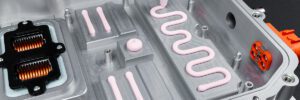WACKER introduces new gap filler for automotive electronics

German chemical manufacturer WACKER Chemie has introduced a new thermally conductive gap filler for applications in vehicle power electronics.
Commercially available as SEMICOSIL 9649 TC, the silicone product can withstand high thermal stresses. It ensures that electronic components have a lasting bond with a vehicle’s active and passive cooling systems, efficiently dissipating the heat generated when a vehicle is in operation.
SEMICOSIL 9649 TC was specifically developed for power electronics applications in electric and hybrid vehicles. The silicone-based compound consists of a 2K system that cures at room temperature through an addition reaction to form an adaptable and repairable elastomer. It is an electrically insulating product with a thermal conductivity of approximately 4 W/mK.

In testing, SEMICOSIL 9649 TC consistently withstood temperatures of up to 150° C without any significant change in its thermal conductivity or other material properties. The product can also deal with thermal shocks that involve rapid temperature changes ranging from -40° C to 150° C, ensuring that bonds between power electronics components and cooling systems remain intact.
SEMICOSIL 9649 TC is a non-sag material before cure. Its viscosity decreases with increased shearing, for example during mixing and metering. Its shear-thinning property is adjusted so that the compound can be fed by machine and applied as a bead so that processors can achieve a high metering rate and high dosing accuracy.
A dispenser is used to apply the gap filler to the heat sink and then the power electronics circuit board is applied. During compression, a continuous film forms that conforms to the surfaces of the two joining parts, evening out surface irregularities and tolerances. The film hardens between the joining parts to form a thermally conductive layer, which, thanks to its soft and flexible consistency, also absorbs vibrations and impacts. The product meets all relevant automotive industry quality standards and specifications.
WACKER has also introduced a new product to insulate busbars in high-voltage EV batteries. The ELASTOSIL R 531/60 is extrudable, which makes sheathing busbars particularly cost-effective. The silicone rubber also improves EV safety. In the event of a fire the product ceramifies, enveloping the busbar in a stable ceramic layer that provides electrical insulation and prevents an undesirable short circuit.
Source: WACKER Chemie
Source link
